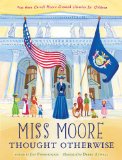
How Anne Carroll Moore Created Libraries for Children
Review posted July 22, 2013.
Houghton Mifflin Books for Children, 2013. 40 pages.
This nonfiction picture book tells, in simple, accessible language, about Anne Carroll Moore, one of the first librarians for children.
The title phrase, “Miss Moore thought otherwise,” is used throughout the book. “In the 1870s many people thought a girl should stay inside and do quiet things such as sewing and embroidery.” “People didn’t think reading was very important for children – especially not for girls.” “Back then, an unmarried girl like Annie might keep house for her parents, or perhaps become a teacher or a missionary.” “New York was a big city. Some people thought it was a dangerous place for a young woman to live on her own.” “She saw that many librarians did not let children touch the books, for fear that they would smudge their pages or break their spines. They thought if children were allowed to take books home, they would surely forget to bring them back.” “When Miss Moore turned seventy years old, it was time for her to retire. Some people thought she should sit quietly at home.”
To all of those things, “Miss Moore thought otherwise.”
And besides telling the attitudes Anne Carroll Moore worked against, the book also displays the positive work she did – such as being an instrumental part of planning the Children’s Room in the New York Public Library’s new Central Branch. There are many pages about the bright and beautiful Children’s Room and what children could do there. I like this little tidbit:
One day the king and queen of Belgium visited the New York Public Library. “You must come see the Children’s Room,” Miss Moore told the queen. That day all the children in the library – from the richest to the poorest – shook hands with a king and queen. (And the picture shows children all lined up to do so, with Miss Moore helping the next in line get ready.)
Notes at the end tell about more trailblazing librarians, give more details, and tell you where you can find out more.
The book text ends with a nice capstone paragraph:
Today libraries across America have thousands of books for children. And thanks to the help of a little girl from Limerick, Maine, who had ideas of her own, any child can choose a book from a library shelf, curl up in a comfortable seat to look through it – and then take it home to read.
